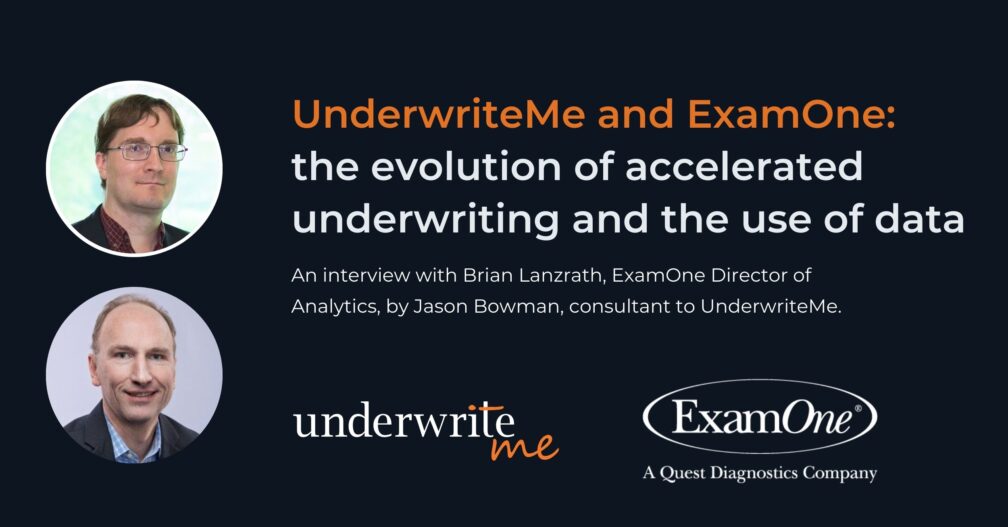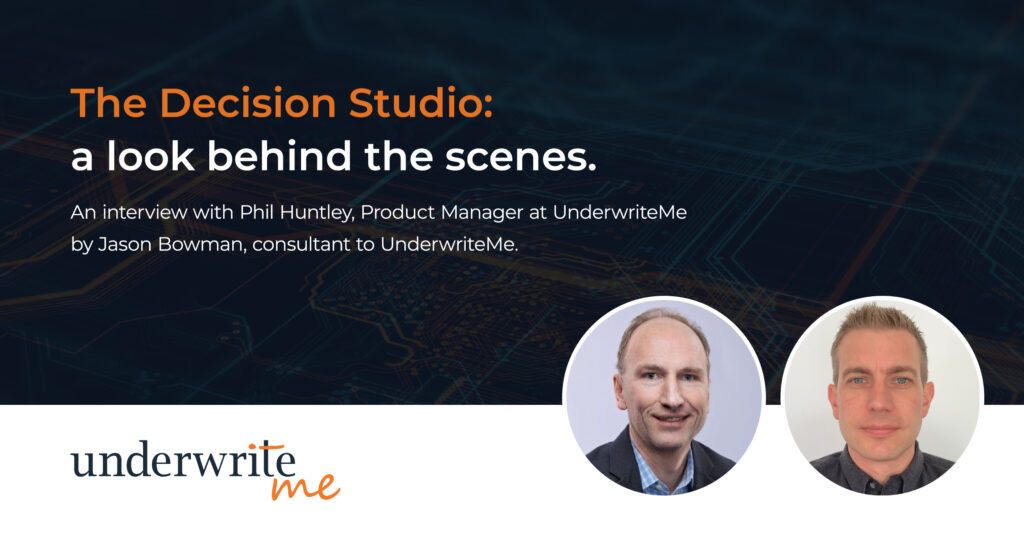May 29, 2024 –
Underwriting Automation Made Easy: The role of data, models and AI with Brian Lanzrath of ExamOne
Continuing the series of interviews with thought leaders in the insurance underwriting world, I caught up with Brian Lanzrath, ExamOne Director of Analytics, to discuss his views on the role of data, models and AI.
Hi Brian. Thanks for sparing some time today. I have followed your path with interest since we first met in 2012. Tell us a bit about your background.
I studied biology (genetics) and after school joined Quest Diagnostics, working in the research and development lab. Over time I moved into more of an analytics role. After Quest acquired Exam One (Lab One) in 2005, I began focusing more on mortality modeling using our extensive history of lab data, dating back to 1992.
What is your role today?
For the last 8 years I have been the Director of Analytics at Exam One. It’s a broad role covering data use across a range of areas including mortality and morbidity modeling, quality analysis and fraud detection. The majority of my work relates to underwriting in one way or another.
We’ve seen some major changes in underwriting over the past decade. How would you assess the current state of our industry?
The big trends will be very familiar to those who have worked in underwriting for a while, particularly the evolution of accelerated underwriting and the use of data to replace or supplement the reliance on laboratory testing. We have been working with some of these data products for a long time (such as prescription history with ScriptCheck which has been around for 20+ years) and now have access to a range of other data sources, including historical lab results, medical claims records and credit histories.
It must be exciting to be on the forefront of a lot of these new developments.
Well, yes although I see the changes as more of a transition than a revolution. Things have progressed a lot but the long term nature of this business means some changes take more time to emerge than we might anticipate. There are still hurdles to overcome particularly with risk factors such as tobacco and build, where data products don’t offer a perfect substitute to traditional evidence.
What are the main data products Exam One provides to the market?
We essentially have 4 main data products: ScriptCheck, LabPiQture, Medical Claims and EHR.
Tell us a bit about the LabPiQture product.
LabPiQture is our tool for accessing historical lab history data in real time. We gather results from a range of lab testing sources, including, but not limited to, Quest Diagnostics. In total we have access to around 70% of the lab tests being performed.* This pulls in tests conducted for any purpose, from routine annual physicals to monitoring cancer treatment. At this stage we have lower coverage for drug testing e.g. for employment purposes but are aiming to increase this over time.
How widely used is LabPiQture?
LabPiQture has quickly become the most valuable data tool in our portfolio. Our studies indicate the risk stratification provided by LabPiQture is over 2.5 times higher than that from prescription or medical claims data alone.* Not surprisingly, the adoption of LabPiQture was greatly accelerated due to COVID.
What are the hit rates with LabPiQture?
The hit rates have steadily increased and are now over 70%. The median number of results (classed as “encounters”) are 2-3 per hit. 60% of hits are within the last 12 months.*
Medical Claims Data is becoming more widely used in the market. Do you think this trend will continue?
Definitely. Whilst hit rates are lower than other sources currently, we are seeing this increase steadily. We can access diagnosis codes on their own and also from LabPiQture (in combination hit rates are up to 70%).
Let’s move on to modeling. This is clearly a major focus for Exam One. How many models have you built?
Well, that depends on how you count them! For instance, our potential condition models look for the likelihood an individual is suffering from a specific condition. In that area we have over 230 models (1 model for each targeted condition). For broader scenarios, we have our main mortality model that draws from all of our data history. In addition, we have a number of carrier specific models that predict underwriting outcome (rather than mortality itself). We are also using data from our wellness unit for morbidity modeling. We are constantly looking at new sources for modeling, for example, we are currently exploring adding medical procedure codes.
Data is providing a huge amount of value in underwriting, but it’s arguably making the manual process more complex for the underwriter. Do you see this as a problem?
The data revolution has definitely created some challenges for the manual process with new and potentially disparate data for the underwriter to review. Our approach is to provide more decision support for underwriters, both through predictive modeling and rules. We have historically delivered a lot through models and are now increasing our rules capabilities through the partnership with UnderwriteMe.
Tell us more about the UnderwriteMe relationship.
The partnership with UnderwriteMe is a strategic initiative for both companies. We are able to enhance our data offering with sophisticated rules from one of the leading rules engines in the market. For UnderwriteMe the relationship increases their North American footprint and enables them to add our data sources to their generic solution.
Which approach do you think is most powerful – rules or models?
The answer varies based on the scenario. In some cases, a model will give the most reliable outcome. However, models require vast amounts of data, and this is not always available. Increasingly I see rules and models being used in combination. For example, the output of a model may be used by an underwriter when developing a new rule.
Finally, let’s talk about AI. Many companies are exploring AI solutions for underwriting. What is your view on the role of AI?
AI is a broad term that can cover a range of technologies including neural networks, models, rules, machine learning and large language models (LLMs). As we just touched on, the most likely role for AI in underwriting will be around decision support rather than automation. One example is the use of AI solutions for automated APS summarizations. When it comes to AI, separating reality from the hype is definitely one of the challenges.
*Based on ExamOne data
_______________________________________________________________________________
Interested in learning more about how ExamOne and UnderwriteMe are collaborating to solve these challenges? Read more here, or reach out to set up a consultation with one of our experts.




